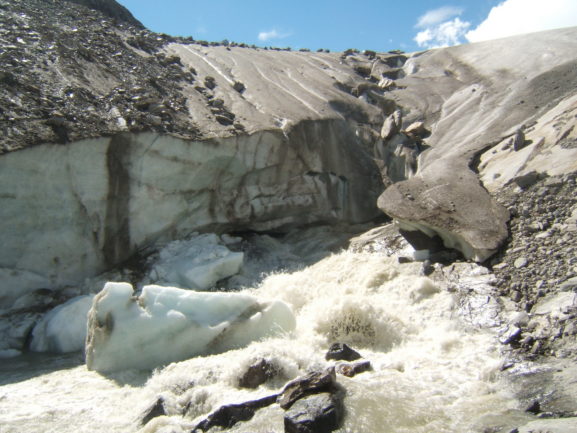Authors: K. A. St. Pierre, V. L. St. Louis, I. Lehnherr, S. L. Schiff, D. C. G. Muir , A. J. Poulain, J. P. Smol, C. Talbot, M. Ma, D. L. Findlay, W. J. Findlay, S. E . Arnott, Alex S . Gardner
As glaciers recede in the arctic, the increase in meltwater may significantly impact downstream ecosystems. Glacial ice can hold thousands of years’ worth of dust, nutrients, and other materials that are released during melting. As the rate of melt increases with a warming climate, the release has the potential to increase nutrient flows and sediment loads, alter pH, and impact other physical, chemical, and biological aspects of downstream watersheds. These changes could negatively impact water clarity and ecosystem function in lakes, rivers, and the ocean.
To better understand the potential impact of increasingly rapid deglaciation, the authors of a paper published last year applied a Land Ocean Aquatic Continuum model (LOAC), a concept that links the changes along a watershed to the resultant outflows to the marine system, to evaluate the potential impact of rapid increases in glacial meltwater in the artic to both lake and ocean environments. The LOAC concept has been applied more commonly in temperate climates where the model typically holds that carbon and nutrients are processed through biological activity and decline as rivers and streams get closer to the ocean. The authors tested this idea in a high Arctic watershed to investigate whether the impacts differed there. The test site was Lake Hazen, a large high artic lake at the northern tip of Ellsemere Island in a watershed dominated by glacial melt inputs. The source ice for the Lake Hazen watershed has recently experienced a 10-fold increase in the volume of meltwater due to rapid warming.
The researchers measured lake inflow and outflow streams, as well as lake sediments to better understand how sediment and nutrients, including carbon, nitrogen, and phosphorus, move from the glaciated head of the watershed through the lake and outflow rivers to the ocean. In contrast to the more studied temperate models, the increasing availability of fine sediments and the lack of vegetation on the recently de-glaciated landscape meant a more complex system with generally increasing inputs downstream of glacial melt zones. Over time, this has the potential to increase nutrient export to the
ocean; however, in Lake Hazen, temperature driven currents caused sediment and sediment-bound nutrients to sink and remain in the lake sediments with little impact to organisms in the lake. Lakes formed and fed through glacial meltwater will increase in number and importance as artic warming continues. Understanding how these lakes use and store sediments and nutrients as they are released from the ice is important to predicting and understanding potential ecosystem impacts throughout the watershed with ongoing warming.
What’s in the Water? by Avery Shinneman is licensed under a Creative Commons Attribution-Share Alike 4.0 International License.

